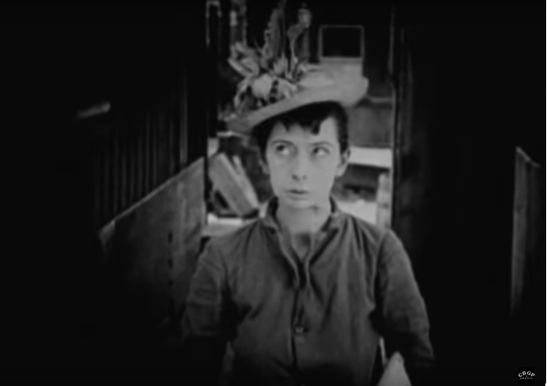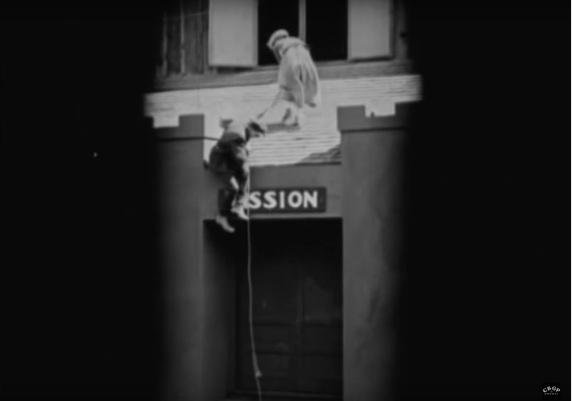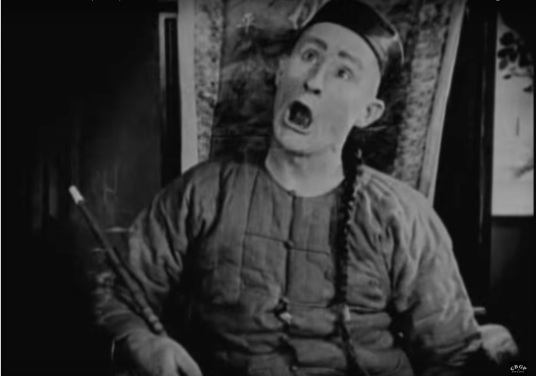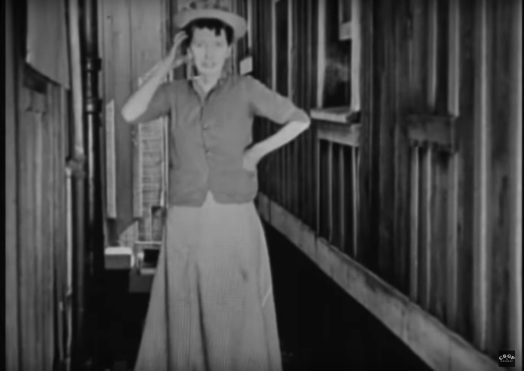Whenever I find a new book about film, especially a book that specifically covers lesser-known comedians, especially if it’s a book that covers women in silent film, I immediately crack it open to the index and look for Henry, Gale.

She usually isn’t there. If she’s mentioned at all, it’s the same tired paragraph. Trained opera singer. Tall and thin, played a lot of spinsters. Probably the physical model for Olive Oyl. Worked with Charley Chase. Opened her own film company that folded after a few years. Trained animals with her husband.
If you’re interested in reading more about her, here is the most comprehensive coverage I have ever found. There is literally more research on her dog than I can find on her.
As my sister can attest, it’s not nearly enough information for me. I research Gale Henry insatiably and force lots of people to watch her extant shorts, but she doesn’t resonate with them like she does with me.
I understand why. Her comedy isn’t subtle. She isn’t conventionally attractive. Her plotlines are, at best, messy. Her surviving films don’t show the same natural storytelling ability as other comedians. She’s also a woman doing comedy, something our society still has trouble with a century later. She’s a less-popular comedienne in a less-popular medium. By all accounts, she’s pretty far down the ladder.
So why is she my first review?
Because she’s fascinating.

Gale Henry’s The Detectress was released in 1919. It stars Gale Henry in the title role, and she works with a cop played by Milburn Morante. You can watch it here. (Fun fact: The director, Bruno C. Becker, would become her husband.)
Spoilers to follow: In the film, Gale takes on the case of a theft: An old man has discovered a wonderful formula for glasses that allow the eaters of chop suey to see what is in it. (Don’t worry – we’ll come back to that.) The formula has been stolen by Jip Yu, a character whose name degrades two ethnicities at once! Gale must pursue the formula back to the villain’s elaborate trap of a home, helped by a sleepy police officer. The two lawkeepers gambole over rooftops and through trapdoors and hidden entrances. Once the formula is reclaimed, Gale Henry wakes up. It seems that she’s been relaxing downwind from some opium users, and that the entire thing has been a fantasy.
Gale’s humor is… broad. The gags are repetitive, the chase scenes are very circular, and the film is rarely punctuated with actual funny moments. (I did like the “One?!? This is me!” moment. I laughed.) However, the action is remarkable because the lanky Gale is as physical as any of her male counterparts. Her comedy is almost brutal as she throws herself over booths, across rooftops, and through revolving doors.

Her determination rings slightly of the Harold Lloyd ethos – if she can only keep going, the tide will eventually turn in her favor.
I found myself wondering, more than once, if I would be holding my breath half as much if it were Keaton or Lloyd doing these stunts. I know the answer. I would hardly bat an eye. Gale Henry surprised me because I wasn’t used to seeing women do this kind of comedy. Even though I am a modern feminist lady, I was surprised to see a woman taking pratfalls.
And part of why Gale Henry so entrances me is that I can’t figure out if it works.
I highly recommend the film, whether you watch it for fun or if you’re dissecting it constantly in your brain like I am. (And I always am.) There are three parts of this film I want to talk about: the cop, the racism, and the opium dream. And yes, those things need to be separated out, because they will go in very different directions.
A.) The Cop
The cop was fascinating for a couple of reasons, partly because I am still in my infancy as an esoteric silent film fan. I know Chaplin and Keaton and Langdon and Lloyd, but we know them because they have lasting qualities. They’ve aged well, like cheese or wine or Ioan Gruffudd. I know why they’ve survived, but I’ve become increasingly interested in the things that didn’t survive. Like Milburn Morante’s cop.

His shoulders are excessively padded, and he wears large white gloves, Mickey Mouse-style. His nose seems to be made-up, possibly to imply drunkenness.
He blew my mind.
I was used to slapstick shoes and funny facial hair and ill-fitting clothing, but I had never seen such inhuman changes made to an actor. Actors wore strange clothes and took advantage of height differences, but the window in which a funny-shaped person was humorous for padding themselves into a funny shape was remarkably brief.
He is also significant because, despite having no personality and being entirely a figment of Gale Henry’s opium dream, he is her equal. We can argue over whether that’s a good or a bad thing, but a man and a woman with no apparent romantic connection tumble through trapdoors and into pools together.
I love that.
B.) Racism
I don’t love that. The racism is overt. Vaguely Chinese characters are played by almost entirely Caucasian characters. In these roles, ‘acting’ is grimacing hugely, crossing some eyes, and stretching the mouths into grotesque pseudo-Chinese syllables. (All of the actors are culpable, but One Lung’s silent solo is the prime offender.)

When Gale Henry orders her food, it is made in squalid conditions. Children and small animals play in the kitchen, the chop suey is marinated in gasoline rather than cooked, and the entire meal is swept into a bowl with a broom. Like, a floor broom. There’s also the ever-popular ‘what is even in Chinese food haha they must be sneak-feeding us LIVE PUPPIES’ gag.

In a side note, my sister and I once went to a Chinese restaurant in a strip mall and found a kitten that had been abandoned in the main parking lot. Every single time we told this story, the listener would crack the same joke: “Guess you never know what’s in your (fill-in-the-blank Asian dish).” General rule of thumb: If your joke about a racial minority was in use a century ago, it’s time to let it go. Better yet, let all of them go. If your jokes rely on ethnic humor, it’s possible that you just aren’t funny. More on that later.
And, as a general overview, all the Asian characters in this film are deceptive and dirty. They partake in opium and they steal. Their names are caricatures because they are caricatures. They write and sing and act in mysterious, incomprehensible ways, but the joke is never on us. For example, when Gale fails to use chopsticks, the gag isn’t that shes bad at it. She doesn’t even hold them both in the same hand. The joke isn’t that Gale is bad at chopsticks, it’s that chopsticks are a dumb invention. The joke falls on the Chinese owners for being different – specifically, for being Asian.
It’s scary and sad how little has changed.
We’ll talk a little bit more about anti-Asian racism when I review The Cheat, but it must be addressed here. Gale Henry’s use of blackface in Her First Flame is similarly damning – she may have been an underdog as a woman, but she showed little sympathy for other marginalized groups. As far as I can tell from her extant films, she frequently used people of color as the butt of her jokes. You can pretend she’s a product of her time, but she frequently worked with Charley Chase, who I’ve never seen use a racial gag. I’m sure there are some, but he certainly doesn’t rely on them. Gale does rely on them, and she goes to no efforts to hire people of color or let them represent themselves.
At this point, you may be frowning at the screen. “Why are you expecting racial sensitivity in the 1910s, Dimly?”
I’m not. But everything happens in context. Silent films expose the grimy, worm-squiggling roots of our racism. And if we don’t talk about where racist stereotypes and portrayals come from, we can’t tell better stories about people of color.
I’m so sorry to cut away, but I promise I’ll talk more about this with The Cheat. This review is already long enough (the film is only 21 minutes long, for crying out loud) so let’s move on to the final section I want to talk about.
3.) The Opium Dream
Let me briefly explain another of Gale’s films. It’s called Her First Flame, and I’ve mentioned it above, but it needs a slight summary, mostly because it is extremely difficult to find.
The film takes place in the distant future of 1950, when men and women have switched gender roles. The main plot is Gale Henry stuffing the ballot box to ensure her own election as fire chief and then saving her fiancé from a fire, but there are cute bits where the fire women hide pin-up boys under their mattresses, the scene where Gale must save a cowering crowd of men from a wind-up mouse, and the parts where Gale initiates romance with her fellow. There is also one hair-raising stunt that I will spoil right now where, while she is carrying her beloved (clearly a dummy) down a fire ladder, Gale flips over backwards, barely catching her feet in the ladder, her head a scant foot above the ground.
At this point, you are scanning the scroll bar at the side to see how much longer I can talk about two-reel films. The answer is forever, but for your sake, I will keep it as short as I can.
Both of these stories rely on framing devices. As far as I can tell from summaries of Gale’s other, lost films, she doesn’t use them in the stories where she plays scrub women or spinsters or landladies. Of course, without the films, I can’t be sure, but these two films rely on these devices. Gale Henry, a woman, can’t be a fire chief unless she makes a joke first about the audience stretching their imaginations toward a distant future. She can’t be a detectress, the equal of her male partner, without mind-altering chemicals introducing the concept.

In a strange way, Gale Henry is trapped in the same way that her Asian characters are. The medium is not willing to accept them in the roles they want. The difference is that Gale, as a white woman, is allowed the medium to mostly control her own story. She can own her own studio. She can imagine herself into positions of power and equality. But she is still limited by her audience – by what they chose to accept.

Gale Henry is fascinating. She relies too heavily on tired slapstick costumes and terrible racist humor, but why? Is it because she can’t imagine her own gags? Or because she hopes that following previous patterns will render her gender irrelevant?
I think it’s the latter. She shines too brightly in secondary roles to be talentless. But without more content that she created, it’s hard to judge her success or failure. And I can’t shake the impression that she’s incredible, if only the right films have survived.
She’s fascinating. She’s a paradox. She’s at the crux of power – her own representation is out of her hands, but she can decide the representation of others. She plays beautifully with gender expectations, but ignores the roles of people of color, letting them fall into tired patterns. Her gender politics are decades ahead, but the slapstick in her surviving films is positively regressive. And yet her natural charm carries her through. She draws the eye. It is so easy to believe that she improved, that she told better stories and created better gags the longer she had freedom.
But there’s no way to know.
So let’s talk about Gale Henry. Let’s find more of her films and do more research until we know for sure. Because she’s incredible.
